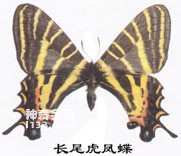The discovery and disclosure of the long-tailed tiger swallowtail butterfly has a long historical process. In 1944, Professor Li Chuanlong, my country's famous butterfly expert, was on his ninth annual butterfly-flying trip to the Qinling Mountains in Shaanxi Province. While climbing over the mountains towards the top of the mountain, he came to two high mountains that can only be seen when looking up. Deep in the dense forest between them, I accidentally picked up a slightly larger and darker tiger swallowtail butterfly, which was confirmed to be a mated female butterfly. Professor Li judged from the long knife-shaped mating derivative extending backward from the end of its abdomen that it was obviously different from the other three tiger swallowtail butterflies and could definitely be a new species. Unfortunately, the two tail processes of its hind wings are broken, so it is impossible to know whether they are thick, thin, long or short. Due to the extremely small number of this butterfly, Professor Li was unable to realize his wish to collect another one. As a scientific worker, his research results must faithfully reflect the objective laws of nature. The scientific evidence for this new butterfly species is incomplete, so we have to put it aside temporarily.

Thirty-seven years later, in order to clarify this question, Professor Li came to the place of origin to explore again in 1981. With the great help of accompanying friends, after more than 20 days of hunting, we finally caught a female butterfly with an intact tail process on the left hind wing. This missing information was completed and the new butterfly was Named the Long-tailed Tiger Swallowtail. In 1981, when Professor Li was invited to attend a special lecture at the 28th Annual Meeting of the Japanese Lepidopteran Society, he announced this new species to the world, attracting the attention of butterfly friends attending the meeting. Some daily newspapers, radio stations, and television stations reported on it. Thirteen years later, Professor Zhou Yao named it Luehdorfia taibai Chou in "Chinese Butterfly Chronicles" because Professor Zhou Yao believed that this species had not been officially published. This is all an academic dispute, and we don’t need to go into detail. It only shows the extraordinary discovery experience of this species of tiger swallowtail butterfly.
The adult wingspan is 55 to 60 mm. The body is black and covered with yellow-white hair. Wings yellow. There are 7 black horizontal bands on the upper half of the forewing, of which the 1st, 2nd, and 4th bands at the base and a wide black band on the outer edge go straight to the rear edge, and there is a row of short yellow stripes embedded in the wide outer edge (outside) and a yellow horizontal line (inside) that seems to be visible but not visible. The outer edge of the hind wings is serrated, with yellow meniscus markings on the tooth recesses, and corresponding inlaid black and yellow-white edges on the outside of the meniscus spots; there are 3 black bands on the upper part of the wings, including 1 at the base. It is wide and diagonally extending from the inner edge to the sub-hip angle; there is a row of crescent-shaped red spots in the middle and rear area, and there is a less obvious row of blue spots on the outside of the erythema; there are round spots composed of red, blue and black colors at the hip angle. The tail process is long. The reverse side of the wings is similar to the front side.
Host: S.henryiOli v. of the genus Saruma in the family Aristolochiaceae.
Biology The water chestnut plant that the long-tailed tiger swallowtail butterfly larvae likes to eat is distributed in small patches in the moist understory beside the ravine and stream in the Taibai Mountain Reserve in the Qinling Mountains of Shaanxi Province. Experiments have shown that hungry larvae can also feed on plants of the genus Asarum and Aristolochia and successfully enter the pupal stage; however, whether it has any impact on the adult stage needs further study. ① Life cycle and life history: One generation occurs per year, the egg stage is from late April to mid-May, the larval stage is from early May to late July, the adult stage is from late April to late May, and the pupal stage is from early July. Early May; ② Mating and egg-laying habits: Adults mate while flying in the air. The female butterfly lays eggs on the underside of the leaves of the host plant. She usually lays 20 to 30 eggs. The eggs are laid singly and arranged in a rectangular or row shape. ③The newly hatched larvae are clustered and arranged neatly with their heads in the same direction; after the fifth instar, they disperse and cause damage. ④ Mature larvae pupate and overwinter on the branches of host plants, in cracks in cliffs, under fallen leaves or in cracks in bark. Zhouzhi County, Shaanxi Province has carried out semi-artificial large-scale breeding in recent years.
Distribution: Shaanxi, Sichuan, Hubei. Endemic to China.
This species is very similar to the Chinese tiger swallowtail butterfly (L.chinensis), but the black transverse bands on the forewings and hind wings are wider than the Chinese tiger swallowtail butterfly, and the remaining yellow part is very narrow, especially under the middle chamber; especially the hind wings The tail process is not only long, but also longer than any other species in the genus Tiger Swallowtail, so it is called the Long-tailed Tiger Swallowtail.
animal tags:
We created this article in conjunction with AI technology, then made sure it was fact-checked and edited by a Animals Top editor.